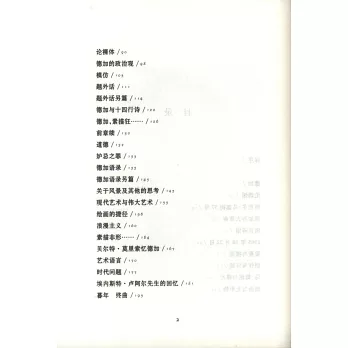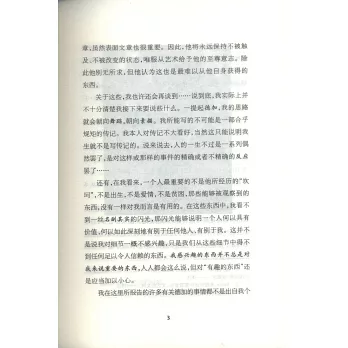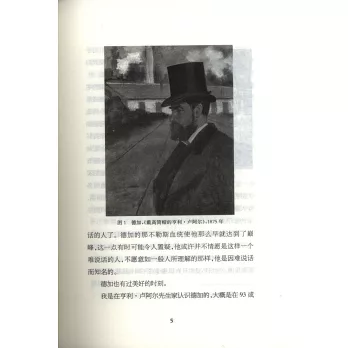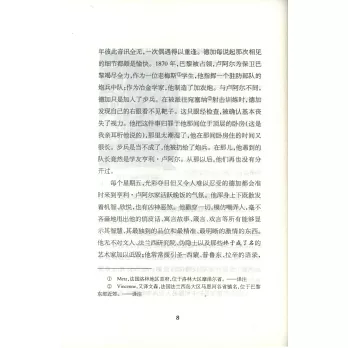禮拜天美術神遊 (77) :
https://www.facebook.com/hanching.chung/videos/4564187746925330

Paul Valéry,... Degas, Danse, Dessin Paperback – 1938

Degas Manet Morisot Paperback – 1989
作者 Paul Valery (Author), David Paul (Translator),
The full text of Valéry's book on Degas, with a long essay on Corot, others on Berthe Morisot, Manet, and Daumier, a personal recollection of Renoir, and writings on sculpture, portraiture, Italian painting, and several minor arts.
***
德加,舞蹈,素描,語言:簡體中文,ISBN:9787567572409,頁數:232,出版社:華東師範大學出版社,作者:(法)保爾·瓦雷里,出版日期:2018/02/01,
內容簡介
Degas, Danse, Dessin. A Tribute to Degas ... - Musée d'Orsay
https://www.musee-orsay.fr › article
As soon as Valéry met Degas, he formed the idea of writing a book about the great painter. In his daily entries in his Cahiers [Notebooks], he jotted down the artist's words and ideas inspired by conversations with him which form the basis of the ...
2021/6/15 Musée d'Orsay: Degas, Danse, Dessin. A Tribute to Degas with Paul Valéry
https://www.musee-orsay.fr/en/events/exhibitions/archives/exhibitions-archives/page/3/article/degas-danse-dessin-46519.html?S=&cHash=92f2cc… 1/6
Cover of "Degas Danse
Dessin"
© DR
Edgar Degas
Self-Portrait in Library
© RMN-Grand Palais (Musée
d'Orsay) / Hervé Lewandowski
Pneumatic card sent by
Degas to Paul Valéry
© Bibliothèque
nationale de France
Degas Danse Dessin
The Musée d’Orsay is celebrating the centenary of the
death of Edgar Degas on 27 September 1917 through
the words of a poet.
This exhibition takes its title from the remarkable but
neglected work by writer and philosopher Paul Valéry
(1871-1945), who is himself unfairly overlooked
today, and uses his finely-honed words to initiate a
dialogue with the works of Degas.
This major text, informed by a friendship between the
two men spanning twenty years, has a distinctive
depth and poetry and is undoubtedly one of the
richest and most sensitive accounts of Degas.
With its fragmented non-biographical structure, and
intimate yet universal tone,Degas Danse Drawingn
ultimately paints a dual portrait – of the artist, whom
Valéry describes with a freedom born of a very close
relationship, and of the genius. The work is also a
meditation on the creative process. Dipping into the
text in the exhibition spaces and reading the images crafted by the writer allows
the beauty of his words to provide an insight into the magical artworks.
In the exhibition, the draughtsman’s line, which the
Musée d’Orsay’s outstanding graphics collection
reflects in all its variety, intersects with lines of
thought. The movement of forms, which interested
Degas throughout his life, and the movement of ideas
to which Valéry devoted himself, are revealed.
The exhibition therefore explores encounters:
between a young man new to Paris whose poetry
precedes him and an acerbic elderly man averse to
scribblers, who were introduced by a mutual circle of
acquaintances including Stéphane Mallarmé, his
friends, and Julie Manet, daughter of Berthe Morisot.
This in turn facilitates an encounter between literature
and the art of drawing which was encapsulated in a
book, and just as the author suggested, on this
anniversary it is moving to peruse “following your
whim, this handful of studies by Edgar Degas”.
Publishing ventures
As soon as Valéry met Degas, he formed the
idea of writing a book about the great painter.
In his daily entries in his Cahiers [Notebooks],
he jotted down the artist’s words and ideas
inspired by conversations with him which form
the basis of the work he wrote nearly forty
years after their first meeting.
In 1899, he came up with the provisional title
“Monsieur D. or painting”. However, it took him
twenty years to submit a proposal for a book
about Degas to art dealer and fine art
publisher Ambroise Vollard in 1929. The title
Degas Danse Dessin [Degas Dance Drawing]
Degas, Danse, Dessin. A Tribute to Degas with Paul
Valéry
ARCHIVE 2017
2021/6/15 Musée d'Orsay: Degas, Danse, Dessin. A Tribute to Degas with Paul Valéry
https://www.musee-orsay.fr/en/events/exhibitions/archives/exhibitions-archives/page/3/article/degas-danse-dessin-46519.html?S=&cHash=92f2cc… 2/6
Paul Valery
Self-Portrait
© Bibliothèque
nationale de France
Edgar Degas
Study after Artemis on
the Parthenon
© RMN-Grand Palais
(Musée d'Orsay) /
Michel Urtado
Edgar Degas
Study for Semiramis Building
Babylon
© RMN-Grand Palais (Musée
d'Orsay) / Tony Querrec
was very quickly abbreviated to DDD.
Vollard met Degas in 1894, at his gallery on the rue Laffitte. As one of the
specialists involved in sales of works from the artist’s studio, he acquired a large
number of items, including many drawings of dancers dating from the period
1880-1900.
He wrote about Degas and also published his work in
the form of books of reproductions and illustrations.
In 1934 he produced La Maison Tellier by Maupassant
featuring monotypes of brothels by Degas.
It took eight years to prepare DDD for publication in
1937, culminating in a luxury edition with a print run
of 305 copies which were very expensive.
This book, which takes the form of a dialogue
between the text and Degas’ engravings and
drawings, both as vignettes within the text and full
plates, is a genuine fine art book, whose initial
purchasers included the dancer Ida Rubinstein and
Pablo Picasso.
Degas the passionate
draughtsman...
Degas, a passionate
draughtsman and an anxious character in the tragicomedy of Modern Art,” made drawing the central
focus of his art, like the Japanese artist Hokusai –
dubbed an “old man mad about drawing” – to whom
Valéry alludes here.
Sales of items from Degas’ studio in 1918 and 1919
revealed the scale of his work to the public and in
particular the staggering volume of drawings
accumulated by the artist since his youth, which he
carefully retained every time he changed studio.
Following the advice of Ingres, he began by modelling
himself on the masters, measuring himself against his
predecessors via the demanding exercise of copying.
During his long spell in Italy from 1856 to 1860, and
subsequently at the Louvre, in the print room of the
Bibliothèque nationale, and in private collections, he
studied classical antiquity, 17th century masters, and
15th and early 16th century Italian artists. He also
embraced great artists of his own century whose work he collected, notably
Ingres and Delacroix.
Figures were Degas’ favourite subject: naked,
wearing drapery, in motion and in portraits. He
studied them from every angle in his
drawings, both as preparation for paintings
and as isolated exercises, trying to achieve
perfection in a single element such as a study
of a nude for Scène de guerre au Moyen Âge
[Scene of War in the Middle Ages], a drapery
for Sémiramis construisant Babylone
[Semiramis Building Babylon] or a face for La
Famille Bellelli [The Bellelli Family] , which are
true masterpieces.
These interconnected sheets form series,
which for Valéry demonstrate the very high
standards set by an artist “plagued by a
pressing need for truth” and “embodying a rigorously classical genius”.
Dance
“Why not talk a little about Dance, about the painter of Les Danseuses?”
Dance is central to the work of Degas and to our perception of his art, but the
world of dance is also a major feature of Paul Valéry’s book.
The painter’s commitment to capturing bodies accurately is coupled with the
challenge of translating their movements. Depicting the fleeting and spontaneous
is a hard task, and this difficulty appealed to the analytical skills of the writer,
2021/6/15 Musée d'Orsay: Degas, Danse, Dessin. A Tribute to Degas with Paul Valéry
https://www.musee-orsay.fr/en/events/exhibitions/archives/exhibitions-archives/page/3/article/degas-danse-dessin-46519.html?S=&cHash=92f2cc… 3/6
Exhibition "Degas Danse Dessin"
© Musée d'Orsay / Sophie Crépy
Edgar Degas
Two Dancers at Rest
© RMN-Grand Palais (musée
d'Orsay) / Hervé Lewandowski
Edgar Degas
Horse, study for Semiramis
Building Babylon
© RMN-Grand Palais (Musée
d'Orsay) / Stéphane Maréchalle
Eadweard Muybridge
who was driven by a tireless quest to decipher the mechanisms of reality around
him.
Degas addressed this issue throughout his
career in a wide variety of media. By turns, he
attempted to capture the structure of forms in
synthetic drawings using a few lines to express
the intention of a body, or allowed colour to
articulate the impetus and grace of subjects
whom Valéry boldly compared to the ethereal
shapes of certain sea creatures.
However, it is undoubtedly to wax, which was
transformed into bronze when the figures
populating his studio were cast shortly after
his death, that Degas devoted the most
energy.
These dancer figures connected by sequential
movements seem to merge into a single figure
depicted at various points in a progression,
while the retina retains the fragmented
elements making up the continuity.
This is reminiscent of contemporary research by photographers, and later by
pioneers of the silver screen, who were instantly fascinated by dance.
Horses, dance and photography
“Horses move on the points of their feet,
borne on four hooves.”
Inspired by Degas’ description in a poem of a
horse as “skittishly naked in its silken coat”,
Valéry believed that “no animal resembles […]
the prima ballerina of the corps de ballet as
closely as a perfectly balanced thoroughbred”.
In his drawings, the artist confers on horses
the same characteristics as dancers. They are
light, ethereal, lean and muscular, and twirl
and rear up by turn, as if they are performing
a figure for observers who admire them for
their beauty and liveliness.
There is however, an additional dimension. For
an era such as the nineteenth century, which
was passionate about motion, horses were a wonderful subject and they feature
very frequently in the optical devices which proliferated throughout the period
and focused with ever greater inventiveness on the moving image.
Phenakistiscopes, zoetropes, praxinoscopes and
other optical toys which Baudelaire described as
“scientific playthings” were widely available and
recreated the image of a horse in motion,
making light of its speed, while scientific studies
of animal and human locomotion by Muybridge
and Marey, with which Degas was familiar,
revealed the sequence of horses’ movements,
2021/6/15 Musée d'Orsay: Degas, Danse, Dessin. A Tribute to Degas with Paul Valéry
https://www.musee-orsay.fr/en/events/exhibitions/archives/exhibitions-archives/page/3/article/degas-danse-dessin-46519.html?S=&cHash=92f2cc… 4/6
Horse Galloping
© Musée d'Orsay, dist. RMNGrand Palais / Patrice Schmidt
harnessing the accuracy of the photographic
medium.
It therefore comes as no surprise that Valéry,
who was particularly drawn to Degas’ photographs, identified a relationship
between his work and the research which culminated in the invention of the
cinematograph.
Chronologie - Degas, Vollard, Valéry
1834
19 July 1834: Edgar Degas is born in Paris.
1845
Degas and Henri Rouart meet at the Collège Louis-le-Grand.
1866
3 July: Ambroise Vollard is born in Saint-Denis de la Réunion.
1871
30 October: Paul Valéry is born in Sète.
Degas begins to suffer from eye problems.
1889
Vollard starts to acquire drawings and engravings, and meets his first painters.
1892
First monographic exhibition devoted to Degas organised by Durand-Ruel.
On a stormy night in Genoa, Valéry experiences an existential crisis which he
refers to as the “Genoese Night”, after which he decides to devote himself to the
life of the soul.
1893
Vollard opens his gallery at 39 rue Laffitte in Paris.
Valéry meets Eugène Rouart, son of Henri Rouart, in Montpellier.
1894
Valéry settles in Paris and begins to write his Cahiers [Notebooks], in which he
records his thoughts every day.
Vollard meets Degas at an exhibition of Manet’s drawings and prints.
1895
Sensing a lack of enthusiasm on the part of the artist, Valéry abandons the idea
of a book about Degas, and writes his Introduction à la méthode de Léonard de
Vinci [Introduction to the Method of Leonardo Da Vinci] instead.
1896
Valéry is introduced to Degas in his studio at 37 rue Victor-Massé by Eugène
Rouart. Although they are a generation apart, Valéry is befriended by Degas, who
nicknames him “the Angel”. They both frequent Henri Rouart’s Friday gatherings
at 34 rue de Lisbonne.
Valéry wants to dedicate to the painter his Soirée avec Monsieur Teste [An
Evening with Monsieur Teste], which was inspired by Degas, but the offer is
declined.
1897
The Musée du Luxembourg exhibits items from the Caillebotte bequest, which
includes seven works by Degas.
1898
Fired with enthusiasm by the artist’s works depicting dancers exhibited at the
Durand-Ruel gallery, Valéry contemplates penning a study on Degas entitled
Monsieur D ou la peinture [Monsieur D. or painting].
1899
An inaugural exhibition is held of books published by Vollard featuring artists.
1900
31 May: the double wedding of Julie Manet and Ernest Rouart and of Jeannie
Gobillard and Paul Valéry, which was encouraged by Degas.
1903
2021/6/15 Musée d'Orsay: Degas, Danse, Dessin. A Tribute to Degas with Paul Valéry
https://www.musee-orsay.fr/en/events/exhibitions/archives/exhibitions-archives/page/3/article/degas-danse-dessin-46519.html?S=&cHash=92f2cc… 5/6
Degas and Valéry become accustomed to spending many summer days together.
1907
Vollard organises a ball where Valéry meets avant-garde painters. Valéry is
disconcerted by them and does not mention these major contemporaries in his
works about painting.
1912
Degas and Valéry are deeply affected by the death of Henri Rouart, which marks
the end of an era. At the Rouart auction, Valéry is unable to buy works by Degas,
which fetch exorbitant prices.
Degas is forced to vacate his studio on the rue Victor Massé and is devastated.
1913
Degas, Cézanne exhibition at the Paul Cassirer gallery in Berlin.
1914
Vollard publishes 98 reproductions signées par Degas (peintures, pastels, dessins
et estampes) [98 reproductions signed by Degas (paintings, pastels, drawings
and prints)].
1915
A camera-shy Degas is filmed without his knowledge by Sacha Guitry in Ceux de
chez nous [Those of our Land], during his daily walk on the boulevard des
Batignolles.
1917
Degas dies of a stroke on 27 September, aged 83.
1918-1919
Despite Degas’ instructions to burn works in his studio which are not worth
preserving, eight sales are organised by Vollard, Durand-Ruel, Jacques
Seligmann and the Bernheim brothers to sell off his works.
1921
Publication of Valéry’s “L’Âme et la danse” [Dance and the Soul], and of the
sonnet by Degas entitled “La Danseuse” [The Dancer] in La Revue musicale.
Moulds are made of 73 sculptures found in Degas’s studio which will be cast in
bronze by Adrien-Aurélien Hébrard.
1923
Vollard establishes the Prix des peintres, a literary prize awarded by painters,
which is won by Valéry.
1924
Vollard’s Degas is published by Crès et Cie.
1925
Valéry is elected to the Académie Française.
1929
In June, Valéry submits his plan for a book about Degas to Vollard. They decide
to publish a one hundred-page work with illustrations from works by Degas. It
will be called Degas Danse Dessin [Degas Dance Drawing]..
1935
Irked by Vollard's tardiness, Valéry releases twelve chapters of his book in five
different magazines.
1936
Degas Danse Dessin is published by Vollard with copperplate engravings by
Maurice Potin and wood engravings by Georges Aubert taken from monotypes
and drawings by Degas.
1937
Degas exhibition at the Orangerie des Tuileries.
1938
Vollard's En écoutant Cézanne, Degas, Renoir [Listening to Cézanne, Degas,
Renoir] is published by Grasset.
1939
On 22 July, Vollard dies aged 73 from a skull fracture sustained in a car crash.
2021/6/15 Musée d'Orsay: Degas, Danse, Dessin. A Tribute to Degas with Paul Valéry
https://www.musee-orsay.fr/en/events/exhibitions/archives/exhibitions-archives/page/3/article/degas-danse-dessin-46519.html?S=&cHash=92f2cc… 6/6
1945
On 20 July, Valéry dies at the age of 73. Following a state funeral, he is buried in
the cemetery overlooking the sea in Sète.
Back to the overview of the exhibition
Back to the list of exhibitions













沒有留言:
張貼留言